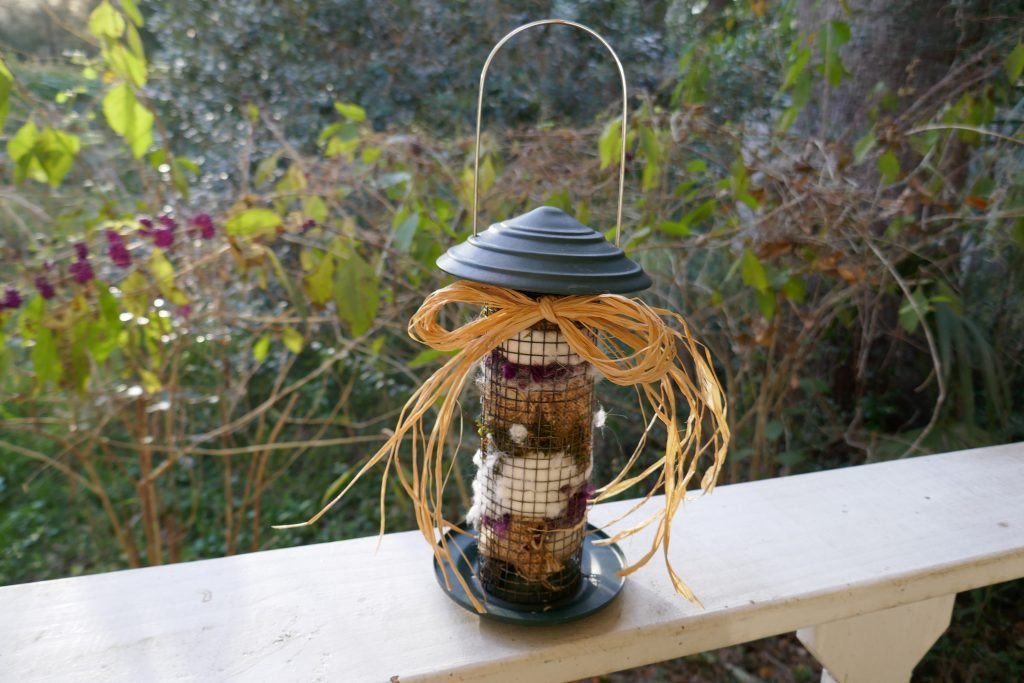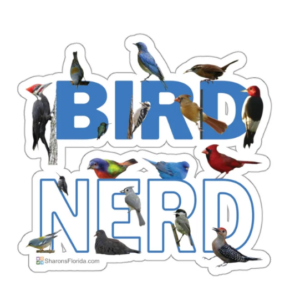How to Provide Nesting Materials for Birds

Birds are always on the look-out for nest-building materials to make their nests bigger and better, softer for their babies, as well as more solid and water resistant.
Providing nesting materials is an easy and fun DIY project. Once your project is finished it will provide a nice variety of nesting materials for your local songbirds to choose from when they are nest building. It also gives you a chance to use up leftover scraps from other projects. It is a great project to do with school children since it’s fast, easy to do, and uses inexpensive materials, or materials already on hand.
A nesting materials DIY project can be made as plain or fancy as you like depending upon what supplies you have on hand. Whether you decide to provide a variety of layered materials, as I’ve done in this example, or a single material, it doesn’t take long to complete, and being creative and resourceful adds to the fun.
In this example I used a leftover mesh bird feeder that I wasn’t using for bird seed. It provided a perfect container to hold the materials and already has a roof and hanging bracket.
Birds are all about getting just the right bits and pieces for their nest construction. They look for soft and supple, as well as strong and sturdy. Birds interweave different materials to create a nest that is both soft and strong. Generally, birds begin with small sticks and twigs for the main structure, add soft things in between and then line the nest with the softest things they can find such as animal hair, feathers, and moss so the babies will not be scratched as they develop and grow. Birds construct their nest with all sorts of things like animal hair, fur, shredded tree bark, plant fibers, sphagnum moss, Spanish moss, lichen, twigs, dried grass, pieces of molted snake skin, leaves, fur, and even spider webs.


At my house Carolina wrens spend a great deal of time picking strands of dog hair out of the welcome mats so I get to watch them collecting quite often. They seem to ignore piles of hair left in the garden, and prefer to pull it out of the rug one strand at a time until they get just the right sized bundle to take to their nest. It is quite comical to see a tiny wren fly by with a big mouthful of hairs covering its eyes, trying to maneuver the bundle back to its nest. Most other birds are shy and secretive and I rarely catch them in the act of collecting nest building materials.
When providing nesting materials, it is best to choose natural fibers such as wool roving yarn (because it is not spun into strands and pulls apart easily), cotton batting, cotton balls, Spanish moss, coconut fibers, dog hair, jute twine, seagrass rope, cabbage palm fibers, leaves (that shred easily like bamboo or palm), and burlap. Natural fibers are easier to pull apart, break down over time, and are usually chemical free for the most part. If using yarn or twine it is best to cut it into small pieces a couple inches in length.
Many sites recommend using feathers, which seems like a natural choice for bird nesting material. However, it is illegal to collect, or possess, feathers from any migratory bird species, which includes any bird species native to the United States. One can possess non-native feathers from such as birds European starlings, Eurasian collared doves, and other introduced species. Feathers from a friend’s pet bird, or chickens, could be a good source, but then again, if the feathers contain harsh chemicals it’s not a good idea as this could negatively impact developing nestlings. The dyed feathers at the craft store are not a good choice because they contain harmful chemicals.
In addition to providing nesting material, in a container of some kind, the savvy gardener can also provide the raw materials that songbirds use naturally as nesting material in other ways by including having plants in the landscape that provide fuzzy seed heads like thistle or fibrous leaves like bamboo and palms. Keeping an untidy garden can also provide them with nesting materials such as fibers from tree bark, mosses, lichens, twigs, dried grass, pieces of molted snake skin, and spider webs. When tying up plants, or vegetables, consider using natural jute to provide another source of material the birds can use.
Please don’t use dryer lint. Dryer lint seems like a good idea, but it will retain moisture, stay wet, and get compacted into a pile that will encourage mold and mildew to grow endangering the bird family, and it most likely contains fabric softener and other chemicals as well, so it is best to avoid it altogether.


Avoiding synthetic nesting materials is the best rule of thumb because they contain chemicals and man-made fibers. Man-made fibers not only contain chemicals, but since they do not break down over time (as natural fibers do), they are far stronger and can tangle, strangle, and cut off circulation in a bird’s body parts. Although many natural fibers have the ability to cause problems, synthetic ones are easy enough to avoid.
Birds are very weary of new items placed in their environment so it may take a while before you see them collecting nest material from your new project, but be patient. If you have leftover bits from your project place them in areas where birds frequent. You can simply place them on the ground, in cracks and crevices of garden stones, or at the base of your plants.
Have fun and enjoy sharing your green space with the birds!



